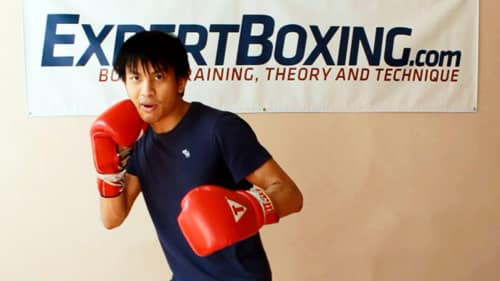
Fighting on the inside is often a messy affair.
It’s usually two guys trying to push each other around and it always feels like you’re either being really defensive (covering up) or being really reckless (trading punches). You need room to punch and strategy to land these punches.
With a little technique and know-how, you can control the position and action on the inside. You can decide WHERE to place your body and the ANGLES of attack.
Learn how to make space and set up your punches for inside fighting.
How to Make Space for Punches on the Inside
1. Foot placement
The first thing is to make sure your feet allow your body to make space for your punches. For example: if you and your opponent are both standing right in front of each other with your feet literally RIGHT NEXT to each other’s feet, you will see that the body (the hips and the torso) has no room to move or make space for your arms.
One way of creating space with your feet is simply to step one foot away. If you want to make space for your right hand punches, step or pivot your right foot away from your opponent. The more space you have between your right foot and your opponent, the more space you have to create leverage for your right hand punches. And vice versa, you will have to place your left foot further away from your opponent if you want to make space for your left hand punches.
There are many ways to move your feet into a new position. It’s most common to step or pivot one foot away from your opponent. But there are also other methods. Some guys will jump and switch stances (orthodox-to-southpaw, or vice versa) because it gives you more space to switch stances on the inside. And other guys may even step AROUND the opponent (rather than away from the opponent). This can also place your head and body into a safer position (to the side of your opponent) while giving you more punching angles.
Common foot placement tricks in inside-fighting:
- Pivot the left foot away, throw a left hook or left uppercut.
- Pivot the right foot away, throw a right hook or right uppercut.
- Pivot or jump around his front foot so that you’re off to his side, then throw hooks.
Pull one foot away to make space for your punches.
2. Upper body placement
Another way to create space when fighting on the inside is through positioning your upper body. You may have noticed that the upper bodies are usually leaning into each other and competing for space on the inside. Both of you are trying to stay balanced and make room for your own punches. In moments like these, you have the option of either moving your upper body to make space for your punches, or moving HIS upper body to make space for your punches, or a combination of the two.
If you’re the stronger one, you can force his upper body back. You can push his upper body off axis by having a stronger body presence at the center (using a superior balance), or you can use your arms and forearms to push him back, or you can throw punches to see if he goes off-axis while trying to slip them. And once he’s tilted off axis, you can keep throwing punches and putting even more pressure because once he’s off balance and already given up his axis, there’s no way for him to regain that center again unless he steps back and resets his stance.
On the flip side, if you’re the weaker one, or if you prefer to be more mobile and use angles on him, you can tilt your own body off center (JUST A LITTLE) and use that space to make room for your punches. A little tilt here and there will give you all the space you need to dig painful hooks and uppercuts on the inside.
Common upper body placement tricks in inside-fighting:
- If you’re heavier, walk into your opponent to make him tilt off balance, then punch at him.
- If you’re the harder puncher, throw many punches to force him off balance, then throw some more as he’s more vulnerable.
- Push him back or down with your front forearm, throw some crosses or uppercuts.
- Tilt your upper body back or to one side to dig hooks and uppercuts.
Move your upper body or move your opponent’s body
to make space for your punches.
Inside Fighting Strategies for Landing Punches
Fighting on the inside is when fighters revert to their most natural instincts rather than trained reflexes. What this means is that you can take advantage of your opponent by coming in with some tricky punching patterns.
Mix up Body Punches with Head Punches
Yes, the classic head-and-body punching strategy. I know it’s the oldest trick in the book and yes, it totally works on the inside. Try digging a couple shots to the body (to drop his elbows) and then throw a big hook to the head. Or do the reverse, throw a bunch of fast pitty-pat punches to the head and then dig a big hook to the body.
Try throwing body-body-body-HEAD,
or head-head-head-BODY!
Move Your Head from One Side to the Other Side
You may have noticed that it’s common for fighters to place their heads near each other’s shoulders when fighting on the inside. The reason for this is because the body naturally fits closer this way. It’s not as common that you have two fighters on the inside with their heads and feet right in front of each other. This is especially true when both fighters are constantly moving off the center to get an angle advantage on their opponent.
One way for you to take advantage in this scenario is to throw punches with your head on one of your opponent’s shoulders, and then quickly move your head to your opponent’s other shoulder. It will make him feel like you disappeared from one side of his body and went to the other. This unexpected change of head position will open up new angles for you to punch from and increase the likelihood that your opponent is not ready to defend them.
Common head placement tricks in inside-fighting:
- Put your head on his left shoulder, throw light fast punches to distract him, then switch your head to his left shoulder and dig a left hook to the body.
- Put your head on any of his shoulders, and then switch your head positions, and quickly fire an uppercut up the middle to his head, or hook to the side of his body that you switched to.
- You can also punch to the side of his head that you exposed. For example: place your head on the left side of his head, and then when you move your head away from there, you fire a punch at the newly-exposed left side of his head.
Throw punches while moving your head
from one side of your opponent’s head to the other side.
Distract with Punches from One Hand, then Hit with the Other Hand
Once again, this is another change-of-pattern tactic. From the inside, throw a bunch of distracting punches with one hand, and then quickly throw a hard punch with the OTHER hand.
Common hand-switching tricks on the inside:
- Throw a bunch of right hands to his head or body, and then quickly throw a big left hook to his head or body.
- Throw a bunch of left hands at his head or body, and then quickly throw a right uppercut up the middle to his chin.
Distract your opponent with punches from one hand,
and then punch with the other hand.
Throw Flurries and Shoeshine Combinations
There will be times when you’re so close or positioned in such awkward ways that you can’t throw any hard meaningful punches on the inside. Maybe you’re both so tired and neither of you have energy to take a step. Or maybe you’re trying to stay close and stall the fight and take a break. Or maybe you’re trapped along the ropes and can’t go anywhere and he’s just leaning on you.
Whatever the case may be, you can still throw punches. In moments like these, I like to throw flurries and shoeshine combinations. These lighter faster punches might lack power and not do any real damage. But they look good, they score points, they show aggression, and might even create openings for bigger punches.
Common flurrying tricks on the inside:
- Get so close to your opponent that all his hard punches are smothered, then throw a bunch of pitty pat punches to his head and body to annoy him.
- Lean on your opponent to trap him along the ropes or in the corner, and throw flurries to keep him there. There’s a good chance the ref won’t break you up if you’re actively punching him.
- Throw a flurry at his guard any time that he’s covering up or being extremely passive on the inside. Make sure you’re careful in case he explodes out of his shell with a counter.
If you don’t have space for big punches,
try throwing faster smaller punches.
This is actually only a teaser article to my upcoming series on inside fighting. I know many of you have been asking me to write on this subject for years and I’m proud to say that I’ve been making serious progress on that. I’ll be going far in-depth into the many different techniques, tactics, and strategies required to fight on the inside. If you have any special requests or concerns about inside fighting tactics, please comment below!





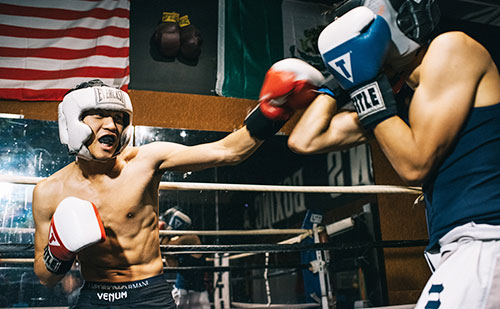
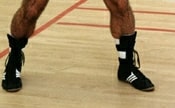


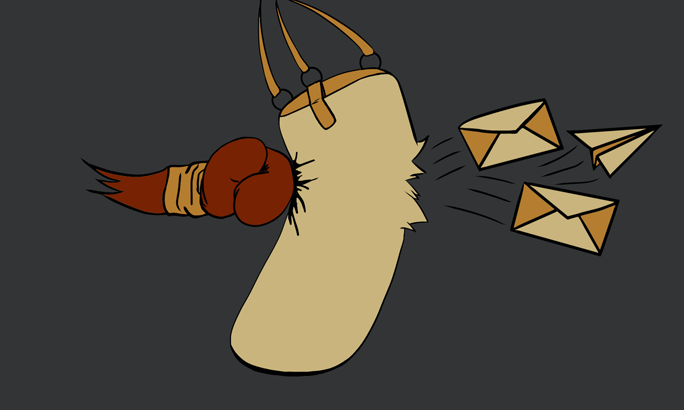
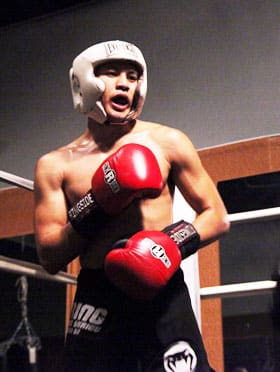
Hey Jonny, i’m a 12 year old male in middle school and my school has a handful of fights every year. I’m 5’5 and i’m not really that big most people are taller then me and fights have only one rule in my school (no kicking). So i thought the best martial art to learn that didn’t involve kicking was boxing. I live near Sugar Ray Leonard boxing center but i’m not trying to become a boxer, I just want the skills to defend myself in a fight. What would be the articles you recommend and I know the how to train i the flinch response is a crucial one, because most punches thrown in fight at my school are wailing super fast hooks, and overhand rights and so forth. Please answer because I want to walk around school with confidence knowing I can defend myself if I need to. Keep in mind my arms are kinda long but they’re are people taller then me. Plus with new technology getting knocked out will be all over the internet in less then a min.
I know it’s probably not the answer you are looking for, but fighting is never a solution to avoid violence. If you truly want to protect yourself from harm, run away. There will always be someone bigger and better than you to knock you out anyway. Don’t try looking on the web to learn how to fight, this WILL get you in more troubles. Go to that boxing gym, and try it. It will give you more than just knowing how to fight !
Start with my “Beginner’s Guide to Boxing” article and go from there. And please…do your fighting in a gym, not in the streets. Be an athlete, not a thug.
Also things like how to cut off the ring wont do me any good because i’m not ring fighting or , or how to use the ropes and things of that nature. Skills in the articles that can transfer over into a real world fight, even fighting drills to practice will be good. Thanks
counters on the inside and dealing with that short sneaky uppercut that pops up down the middle.
Hehehe…yes, the sneaky uppercut up the middle! That will be in there.
vou posta uns videos pra vc analizar
I have a request. Could you touch on smothering and inside fighting a fighter while leaning on him on the ropes in your future inside fighting article.
Yes, this will definitely get covered in the future!
Also could you touch on punching your way INTO the clinch
Yes, this one will be in it for sure!
I’ve been sitting on my ass and smoking too much weed. Gotta get back into boxing but I can’t last even 30 seconds without getting tired to the point where I almost faint. Is it just cardio that I need to start on again or is this unnatural? I weightlift and I’m 17 so idk what’s going on. Anyone else have this problem?
Weed doesn’t affect lungs much but it does affect the brain, impairing your balance, reaction, coordination, etc. and makes you suffer from thirst, which might be why you tire so fast in sparring. Now if you took it right before or shortly before your sparring session, then that totally explains why you tired like that as your heart rate would have been a lot higher.
It’s not unnatural to tire within 30 seconds if you really have been sitting on your ass that much. Maybe you haven’t been in the ring too long and are overreacting to punches draining stamina. To make things worse, you used to have stamina and now you don’t. To make things even more worse, you now weightlift (if you are weightlifting the way Johnny says not to, which you probably are).
Also, you should not smoke them, especially at your age it will lead to impairment in adulthood, aside from the side effects you “might” already be suffering from. So yes you definitely need to start on cardio again, and it “might” be unnatural, although it is reasonable to gas out in 30 secs as well if you just started sparring.
Yeah…you need some serious cardio!
I hardly recognized you with all of that hair man.
😉
hey johny i heard pacquiao is preparing himself at wildcard,is that true?
Yes, he is. It’s true.
Hi,
I would like to something on holding your oppenent to slow things down a bit. Also, give a more comprehensive advice on jump rope selection.
Yes…holding opponents and stalling fights will be there for sure. In regards to the jump rope selection, I’ve left a purchase link for the best jump rope I’ve found. It’s in my “Boxing Jump Rope Training Guide”.
hello everybody!
just want to ask a little question, when i work on the left hook on a bag or even a sparring partner, i feel like i have to make a huge space on the side i hit… If i don’t, my arm is too bend and I hurt myself a bit, does someone feel the same thing?
thanks for your reply, and good training guys!
You are totally accurate, Adri! You need space for the arm. The elbow should not be “behind” your shoulder when you punch or else you feel stress in the shoulder or chest somewhere. Either you rotate your body or make space through foot positioning or body positioning in order to land the left hook.
thanks a lot for your reply johnny!
Good video. you should do another video showing us how it would looking in a real boxing match with an opponent. I’m a little confused.
Watch Miguel Cotto or Ricky Hatton in fights and you will see them making similar types of movements. Julio Cesar Chavez is another good one as well.
It’d be great to get an article on inside fighting from a southpaw (or rather southpaw vs orthodox) perspective. I’m a southpaw and have always felt more comfortable working off the jab and moving on the outside but am now trying to develop my infighting skills so I can mix it up a bit more. Some of the stuff in this one would carry across but there are definitely some considerations with regards to foot and body placement that would be really good to get your opinion on along with other any other tactics and tricks.
Having a southpaw stance can be very useful for infighting purposes, actually. I do recommend for orthodox fighters to momentarily square up or even turn southpaw at certain times for infighting. More on that when the article comes out.
If you could write a bit on inside techniques that don’t necessarily include fighting. Mayweather degrades and demoralises physically stronger brawlers on the inside without ever being caught up in a brawl.
Cheers
Leroy
Yes…it will be covered in my inside fighting article. There are so many clever ways to “fight” on the inside without actually having to throw or take a punch.
Head movement on the inside is not so common anymore imo. What do you think of James Toney? His angles on the inside were truly amazing.
No true at all! It’s just that it’s so subtle that you can’t see it on TV. You have to watch it in person…better yet, get in the ring with a pro and then tell me “head movement on the inside” isn’t common anymore.
It’s great how you teach boxing. A lot of the younger newer generations want to fight and it’s rare to find the beautiful fundamentals of boxing now days awesome
Thanks, J.
can’t wait for that next article
hai J, i love your wesbsite, btw i’m from Indonesia.
Can you give me an advice to improve my skill, i have hard punch but slow, fast footwork but bad body movement, do you think “inside fighting” is good for my fighting style?
Hi Johnny,
I have need for some tips regarding close range fighting. I have relatively short arm compared to my height, thus i often have to get into the inside just to reach my opponent. I struggle just to keep in range, it’s way too easy for my opponents just to step back or step in and mess up my poor attempt at punching them. I’m not scared to get in close range (or trade punches), but i find it really difficult getting around their guard, especially if they have much longer arms than me and can easily cover most of their body (or they just get in the way). I’m not sure what i can do to get around the problem without just getting way faster and agile than i currently am. Is there a way?
Philippe,
Take Rocky Marciano as an example and wathc his fights. He had short arms too and was a great fighter.
Hey Johnny,
Ever since I found your website my boxing has improved exponentially.
I was wondering do you know any guys that understand wrestling as you do with boxing?
I do self defense and box guys with wrestling backgrounds. I think it would greatly improve my inside fighting.
Thanks.
Thanks for the kind words, Kenneth. I’m sorry but I don’t know much about wrestling or who the credible instructors are. I hope you find someone good!